There are about 11 genera and 54 species of leporids (rabbits and hares) and two genera and 26 species of pikas extant. Distribution is nearly worldwide, but oceanic islands, Australia, and southern South America lack native lagomorphs (as, of course, does Antarctica).
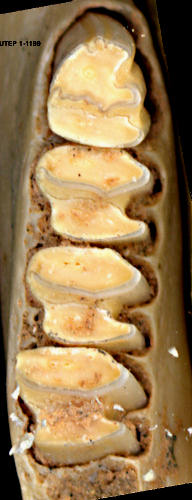
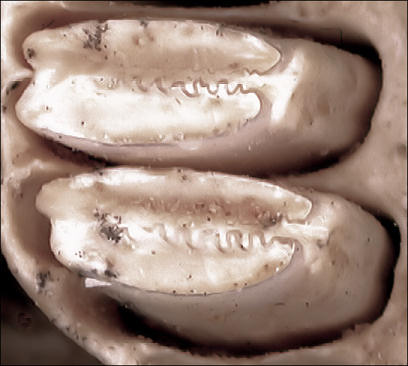 Lagomorphs differ from other orders in the presence of peg-like second incisors directly behind the grooved upper first incisors. The tooth
formula is 2/1 0/0 3/2 2-3/3 = 26 - 28. There is a major diastema separating the incisors from the cheek teeth. All teeth are hypselodont, and cheek teeth are lophodont (typical upper
and lower cheek teeth are shown in Figs. 1 and 2). The distal portion of the fibula is fused to the tibia. Although skeletal features are easily recognizable as being lagomorph, differences
between species usually are subtle. All lagomorphs are herbivores. A variety of lagomorphs are pictured on the Animal Diversity Web. Also see the Ochotonidae and the Leporidae from the Smithsonian fieldguide series.
Lagomorphs differ from other orders in the presence of peg-like second incisors directly behind the grooved upper first incisors. The tooth
formula is 2/1 0/0 3/2 2-3/3 = 26 - 28. There is a major diastema separating the incisors from the cheek teeth. All teeth are hypselodont, and cheek teeth are lophodont (typical upper
and lower cheek teeth are shown in Figs. 1 and 2). The distal portion of the fibula is fused to the tibia. Although skeletal features are easily recognizable as being lagomorph, differences
between species usually are subtle. All lagomorphs are herbivores. A variety of lagomorphs are pictured on the Animal Diversity Web. Also see the Ochotonidae and the Leporidae from the Smithsonian fieldguide series.
Fig. 1 (left). Upper right M1-2 of Sylvilagus. The reentrant loop of crinkled enamel extends most of the way across the tooth and is filled with cement. Fig. 2 (right). Lower right p3-m2 of a cottontail (Sylvilagus). the trigonid of a tooth is separated from the talonid by a cement-filled medial lateral reentrant extending almost entirely across the tooth.
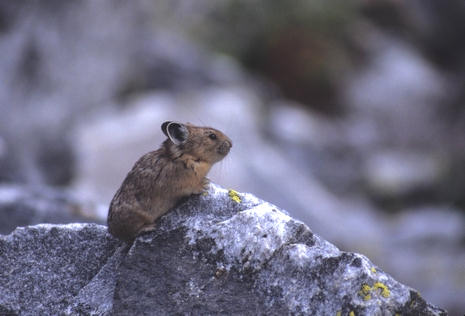 Pikas are Asiatic and North American in distribution.
Depending on the species and geographic area, they may occur from near sea level to well above timberline, from steppe and forest habitats to alpine talus slopes. Two species occur in North
America. Ochotona collaris occurs in Alaska and adjacent Canada (Yukon, Northwest Territories), while the American Pika (O. princeps) is widespread in montane regions of western
Canada south to northern New Mexico and southern California. In New Mexico, it is limited to high elevation talus slopes and, judging from its absence in fossil faunas farther south, apparently
never made it across intervening lowlands to suitable habitats in the Pleistocene timberline regions of the southern mountain masses.
Pikas are Asiatic and North American in distribution.
Depending on the species and geographic area, they may occur from near sea level to well above timberline, from steppe and forest habitats to alpine talus slopes. Two species occur in North
America. Ochotona collaris occurs in Alaska and adjacent Canada (Yukon, Northwest Territories), while the American Pika (O. princeps) is widespread in montane regions of western
Canada south to northern New Mexico and southern California. In New Mexico, it is limited to high elevation talus slopes and, judging from its absence in fossil faunas farther south, apparently
never made it across intervening lowlands to suitable habitats in the Pleistocene timberline regions of the southern mountain masses.
The American Pika (Ochotona princeps). Photograph by John J. Mosesso, courtesy of NBII.
Morphologically, the Pika is about the size of a guinea pig. The ears are short and rounded; there is no visible tail. The grooved front incisors are deeply notched, whereas those of leporids have little or no notch.
Pikas are known for their storing of plant food for use during the winter (they remain active throughout the year). Plants clipped from the vicinity of talus is spread out to cure (and moved into a dry area if rain threatens); after curing, it is stacked in a secure place for use during the winter.
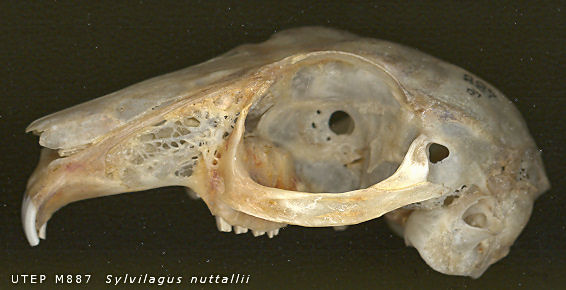 The typically
fenestrated skull, second incisor situated behind the first, and long diastema are seen in Fig. 1. The skull shown is typical of leporids, as is the dentary shown in Fig. 2.
The typically
fenestrated skull, second incisor situated behind the first, and long diastema are seen in Fig. 1. The skull shown is typical of leporids, as is the dentary shown in Fig. 2.
Although superficially similar, and often difficult to tell apart without attention to detail, rabbits and hares differ considerably. A major difference is that rabbits such as the cottontails (Sylvilagus) have altricial young and the hares have precocialyoung. Altricial young are born helpless, with eyes and ears sealed, and require an extended time of maturation before they are ready to leave the nest. The precocial young of hares are born with unsealed eyes, are fully furred, and are able to hop about and leave the form within a few hours. The most noticeable skeletal difference is in that the interparietal bone is separate in the adult in rabbits (that is, a suture is visible between interparietal and surrounding bones) but is fused in hares.
Fig. 2 (above, right). Lateral view of the skull of a Mountain Cottontail (Sylvilagus nuttallii). Fig. 3 (below, left). Lateral view of the mandibles of a Desert Cottontail (Sylvilagus audubonii).
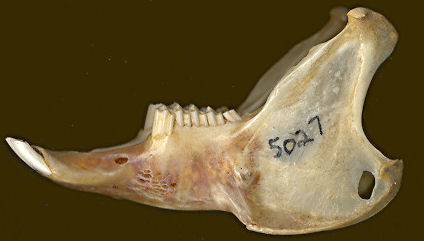 Native hares of
North America all belong to the genus Lepus (which also occurs in the Old World). Several species occur in the New Mexico/Trans-Pecos Texas area. The Snowshoe Hare (L. americanus)
occurs in the high mountains of northern New Mexico north to all but northernmost Alaska and Canada. In eastern Canada during the 19th Century, it was an important ingredient of the fur trade.
Native hares of
North America all belong to the genus Lepus (which also occurs in the Old World). Several species occur in the New Mexico/Trans-Pecos Texas area. The Snowshoe Hare (L. americanus)
occurs in the high mountains of northern New Mexico north to all but northernmost Alaska and Canada. In eastern Canada during the 19th Century, it was an important ingredient of the fur trade.
The White-tailed Jack Rabbit (L. townsendii) barely enters New Mexico in high-elevation grasslands in the north-central part of the state. Farther north, it descends to lower grassland habitats in the Great Basin and Central and Northern Great Plains. The rest of New Mexican grasslands (and occasionally to as high as open Ponderosa Pine) is inhabited by the Black-tailed Jack Rabbit (L. californicus). Overlapping in the grasslands of the extreme southern part of the New Mexican bootheel is the White-sided Jack Rabbit (L. callotis). The Snowshoe Hare is almost cottontail-like in external appearance and easily told from the other jack rabbits. The other three species differ from one another by minor differences in coloration (thus the common names), but extremely close in terms of skeleton and skull.
Fig. 4. Comparison of the jackrabbit interparietal area (left) with that of a cottontail (right). The sutures have been enhanced for easy discrimination. The suture between the supraoccipital and the parietal/interparietal area is seen on both. The depressed, fenestrated area anterior to the supraoccipital in the jackrabbit is approximately the equivalent of the interparietal seen in the cottontail, but not separated from the parietal by a suture as it is in the cottontail.
Go to the Sylvilagus page.
Last Update: 11 Feb 2008
Centennial Museum and Department of Biological Sciences, The University of Texas at El Paso